Affect of Bullying in Australian Primary Schools
VerifiedAdded on 2022/11/22
|16
|4076
|415
AI Summary
The paper attempts to highlight the affects that bullying has on the learning and development of children in primary schools. It presents the bullying as a growing issue in the country and explains the theories based on which the mindset of the bully and the victim can be explained. The report also brings forth the potential impact that bullying imposes on the learning abilities of the child and the effect it has on the child’s psychosocial development. The solution for the issue can be found by proper application of inclusive education policies from the early years of a child’s education.
Contribute Materials
Your contribution can guide someone’s learning journey. Share your
documents today.
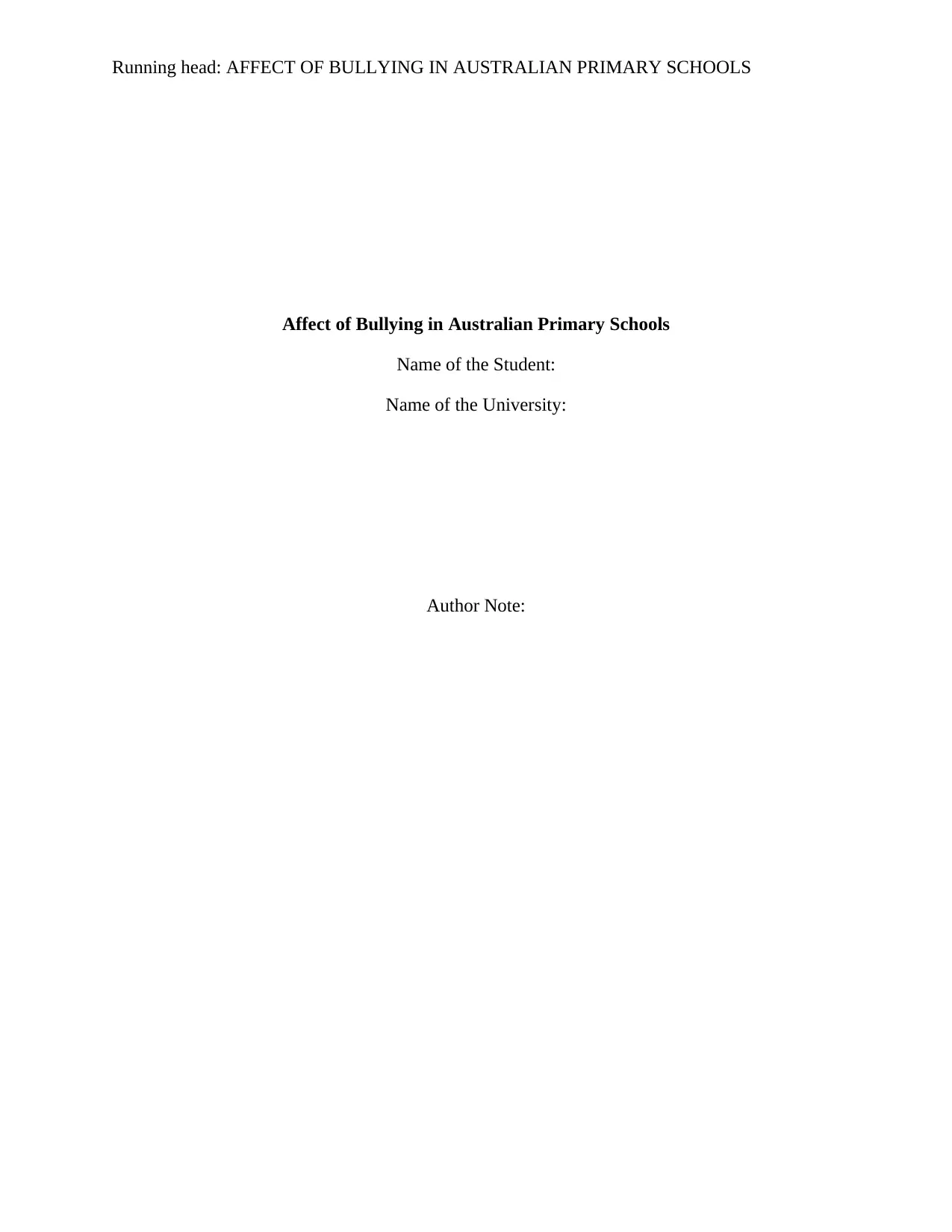
Running head: AFFECT OF BULLYING IN AUSTRALIAN PRIMARY SCHOOLS
Affect of Bullying in Australian Primary Schools
Name of the Student:
Name of the University:
Author Note:
Affect of Bullying in Australian Primary Schools
Name of the Student:
Name of the University:
Author Note:
Secure Best Marks with AI Grader
Need help grading? Try our AI Grader for instant feedback on your assignments.

AFFECT OF BULLYING IN AUSTRALIAN PRIMARY SCHOOLS
Executive Summary:
The paper attempts to highlight the affects that bullying has on the learning and development of
children in primary schools. It presents the bullying as a growing issue in the country and
explains the theories based on which the mindset of the bully and the victim can be explained.
The theories lead the way to the factors that contribute in the encouragement of the act of
bullying and show the importance of the role of teachers, schools and family in the life of the
bully and the bully-victim. The report also brings forth the potential impact that bullying imposes
on the learning abilities of the child and the effect it has on the child’s psychosocial
development. The solution for the issue can be found by proper application of inclusive
education policies from the early years of a child’s education.
Name and Student Number Page 1
Executive Summary:
The paper attempts to highlight the affects that bullying has on the learning and development of
children in primary schools. It presents the bullying as a growing issue in the country and
explains the theories based on which the mindset of the bully and the victim can be explained.
The theories lead the way to the factors that contribute in the encouragement of the act of
bullying and show the importance of the role of teachers, schools and family in the life of the
bully and the bully-victim. The report also brings forth the potential impact that bullying imposes
on the learning abilities of the child and the effect it has on the child’s psychosocial
development. The solution for the issue can be found by proper application of inclusive
education policies from the early years of a child’s education.
Name and Student Number Page 1
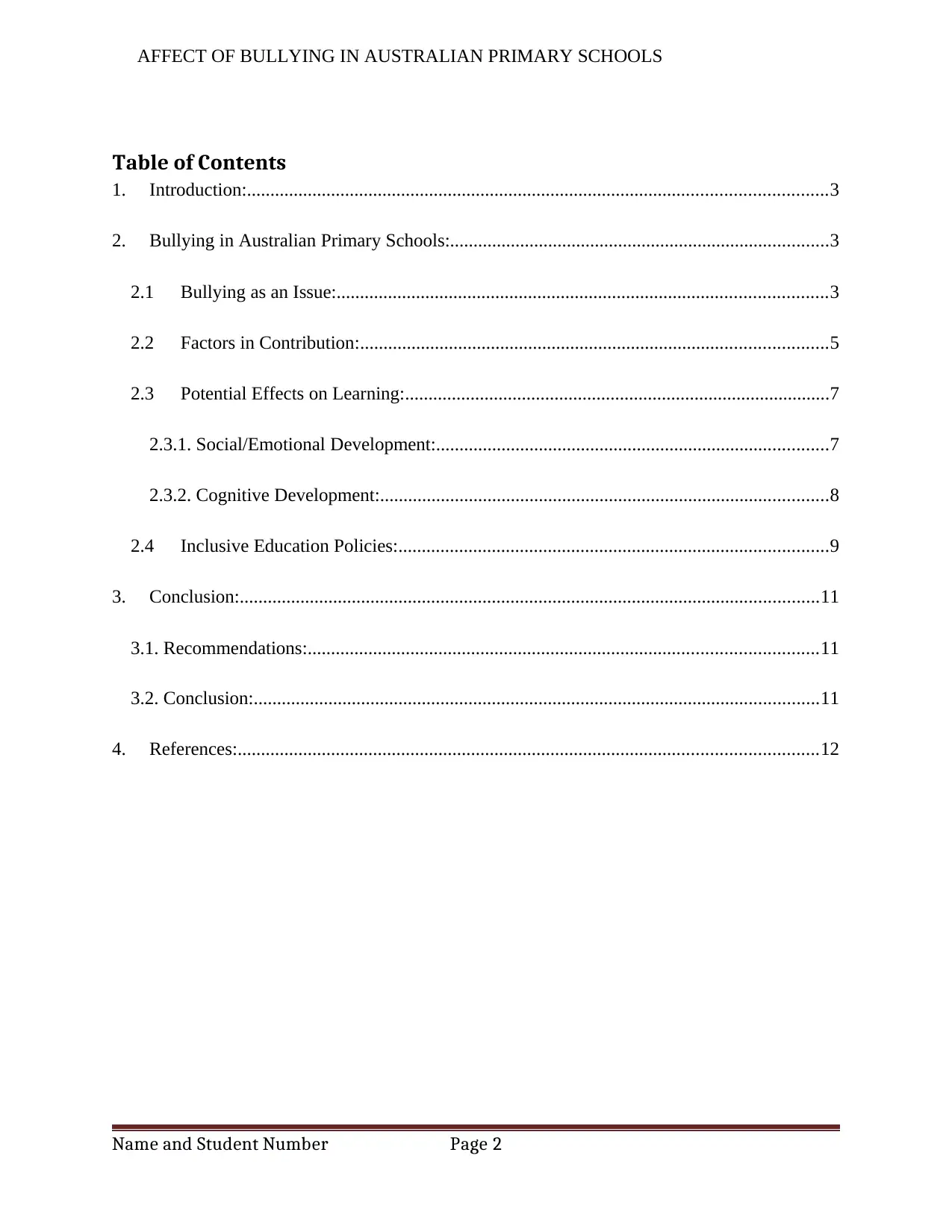
AFFECT OF BULLYING IN AUSTRALIAN PRIMARY SCHOOLS
Table of Contents
1. Introduction:............................................................................................................................3
2. Bullying in Australian Primary Schools:.................................................................................3
2.1 Bullying as an Issue:.........................................................................................................3
2.2 Factors in Contribution:....................................................................................................5
2.3 Potential Effects on Learning:...........................................................................................7
2.3.1. Social/Emotional Development:....................................................................................7
2.3.2. Cognitive Development:................................................................................................8
2.4 Inclusive Education Policies:............................................................................................9
3. Conclusion:............................................................................................................................11
3.1. Recommendations:.............................................................................................................11
3.2. Conclusion:.........................................................................................................................11
4. References:............................................................................................................................12
Name and Student Number Page 2
Table of Contents
1. Introduction:............................................................................................................................3
2. Bullying in Australian Primary Schools:.................................................................................3
2.1 Bullying as an Issue:.........................................................................................................3
2.2 Factors in Contribution:....................................................................................................5
2.3 Potential Effects on Learning:...........................................................................................7
2.3.1. Social/Emotional Development:....................................................................................7
2.3.2. Cognitive Development:................................................................................................8
2.4 Inclusive Education Policies:............................................................................................9
3. Conclusion:............................................................................................................................11
3.1. Recommendations:.............................................................................................................11
3.2. Conclusion:.........................................................................................................................11
4. References:............................................................................................................................12
Name and Student Number Page 2
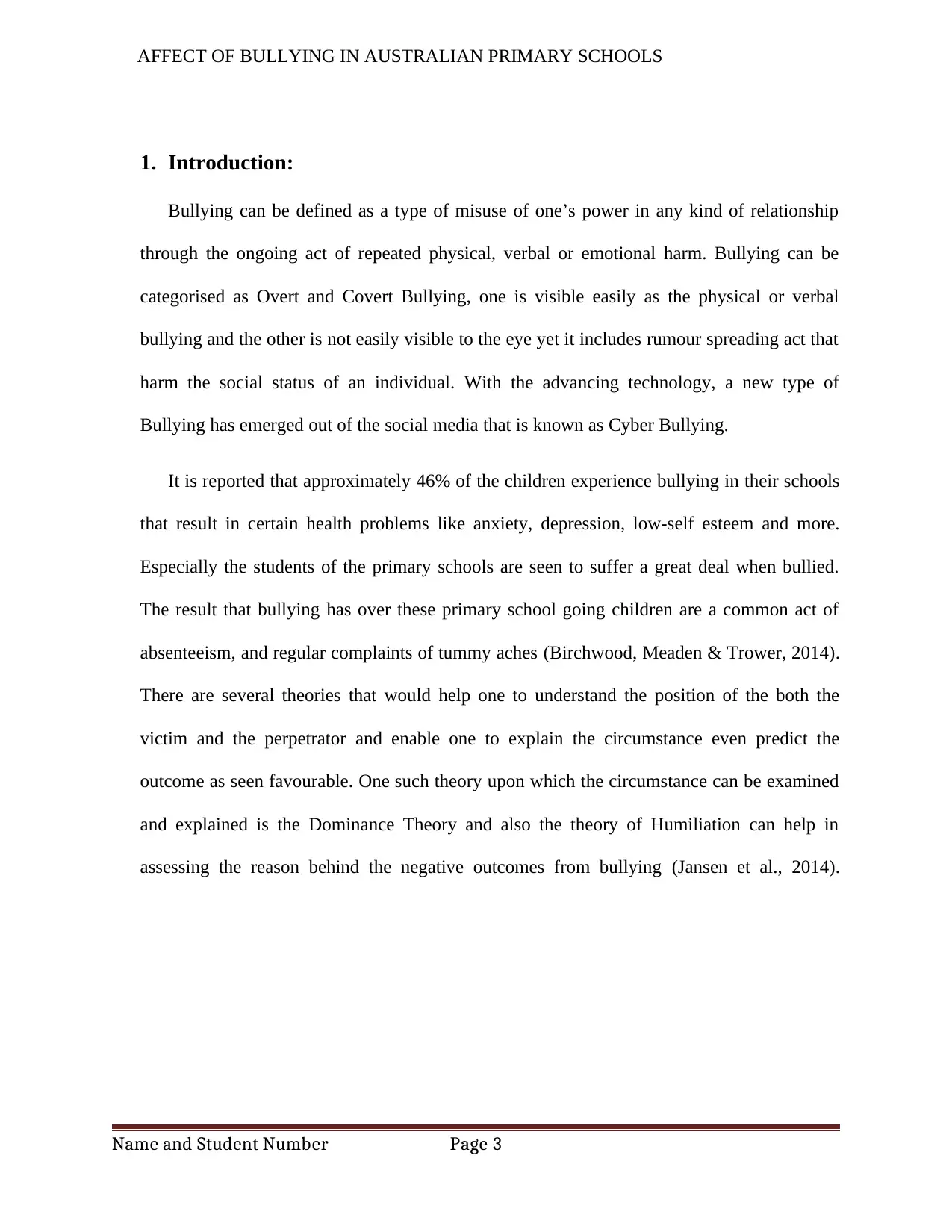
AFFECT OF BULLYING IN AUSTRALIAN PRIMARY SCHOOLS
1. Introduction:
Bullying can be defined as a type of misuse of one’s power in any kind of relationship
through the ongoing act of repeated physical, verbal or emotional harm. Bullying can be
categorised as Overt and Covert Bullying, one is visible easily as the physical or verbal
bullying and the other is not easily visible to the eye yet it includes rumour spreading act that
harm the social status of an individual. With the advancing technology, a new type of
Bullying has emerged out of the social media that is known as Cyber Bullying.
It is reported that approximately 46% of the children experience bullying in their schools
that result in certain health problems like anxiety, depression, low-self esteem and more.
Especially the students of the primary schools are seen to suffer a great deal when bullied.
The result that bullying has over these primary school going children are a common act of
absenteeism, and regular complaints of tummy aches (Birchwood, Meaden & Trower, 2014).
There are several theories that would help one to understand the position of the both the
victim and the perpetrator and enable one to explain the circumstance even predict the
outcome as seen favourable. One such theory upon which the circumstance can be examined
and explained is the Dominance Theory and also the theory of Humiliation can help in
assessing the reason behind the negative outcomes from bullying (Jansen et al., 2014).
Name and Student Number Page 3
1. Introduction:
Bullying can be defined as a type of misuse of one’s power in any kind of relationship
through the ongoing act of repeated physical, verbal or emotional harm. Bullying can be
categorised as Overt and Covert Bullying, one is visible easily as the physical or verbal
bullying and the other is not easily visible to the eye yet it includes rumour spreading act that
harm the social status of an individual. With the advancing technology, a new type of
Bullying has emerged out of the social media that is known as Cyber Bullying.
It is reported that approximately 46% of the children experience bullying in their schools
that result in certain health problems like anxiety, depression, low-self esteem and more.
Especially the students of the primary schools are seen to suffer a great deal when bullied.
The result that bullying has over these primary school going children are a common act of
absenteeism, and regular complaints of tummy aches (Birchwood, Meaden & Trower, 2014).
There are several theories that would help one to understand the position of the both the
victim and the perpetrator and enable one to explain the circumstance even predict the
outcome as seen favourable. One such theory upon which the circumstance can be examined
and explained is the Dominance Theory and also the theory of Humiliation can help in
assessing the reason behind the negative outcomes from bullying (Jansen et al., 2014).
Name and Student Number Page 3
Secure Best Marks with AI Grader
Need help grading? Try our AI Grader for instant feedback on your assignments.
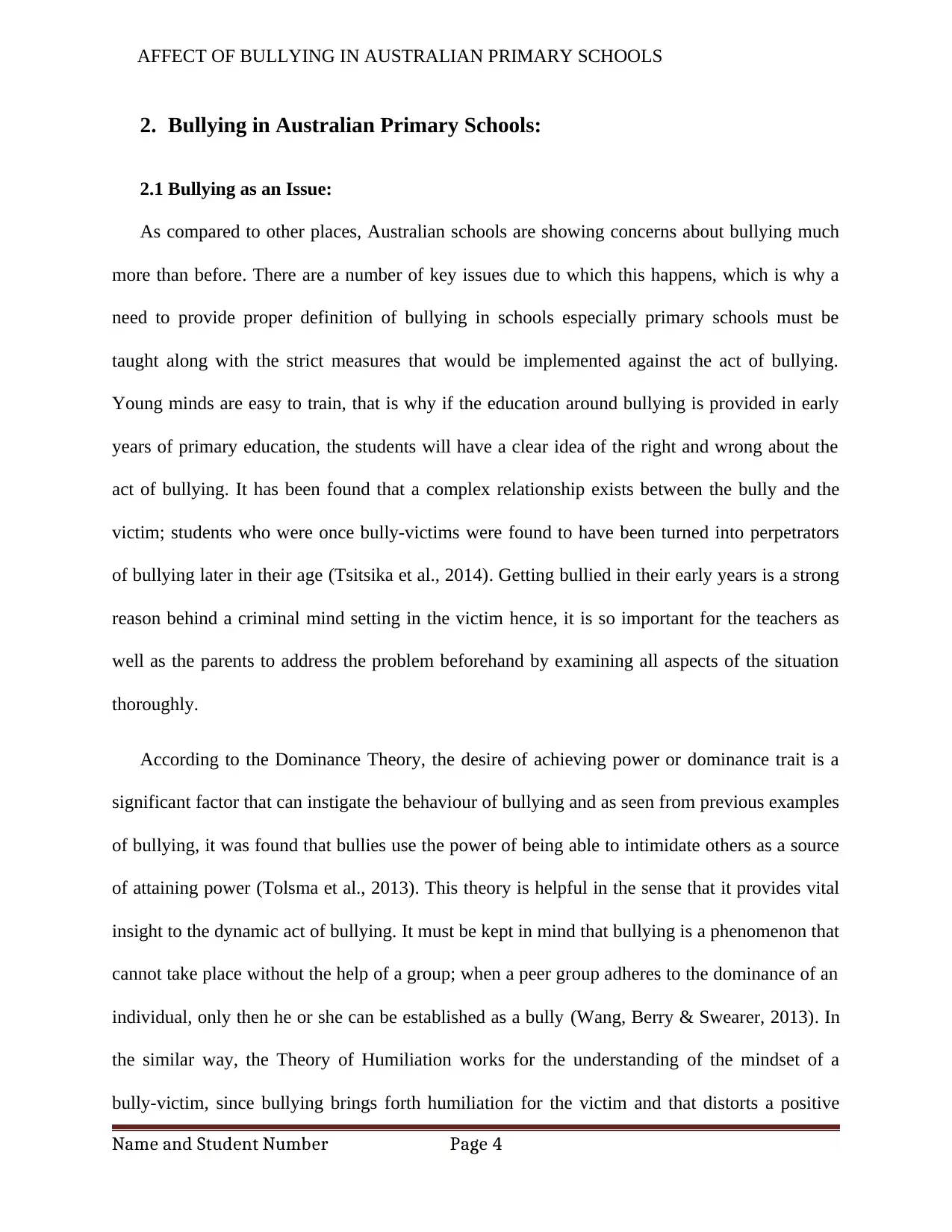
AFFECT OF BULLYING IN AUSTRALIAN PRIMARY SCHOOLS
2. Bullying in Australian Primary Schools:
2.1 Bullying as an Issue:
As compared to other places, Australian schools are showing concerns about bullying much
more than before. There are a number of key issues due to which this happens, which is why a
need to provide proper definition of bullying in schools especially primary schools must be
taught along with the strict measures that would be implemented against the act of bullying.
Young minds are easy to train, that is why if the education around bullying is provided in early
years of primary education, the students will have a clear idea of the right and wrong about the
act of bullying. It has been found that a complex relationship exists between the bully and the
victim; students who were once bully-victims were found to have been turned into perpetrators
of bullying later in their age (Tsitsika et al., 2014). Getting bullied in their early years is a strong
reason behind a criminal mind setting in the victim hence, it is so important for the teachers as
well as the parents to address the problem beforehand by examining all aspects of the situation
thoroughly.
According to the Dominance Theory, the desire of achieving power or dominance trait is a
significant factor that can instigate the behaviour of bullying and as seen from previous examples
of bullying, it was found that bullies use the power of being able to intimidate others as a source
of attaining power (Tolsma et al., 2013). This theory is helpful in the sense that it provides vital
insight to the dynamic act of bullying. It must be kept in mind that bullying is a phenomenon that
cannot take place without the help of a group; when a peer group adheres to the dominance of an
individual, only then he or she can be established as a bully (Wang, Berry & Swearer, 2013). In
the similar way, the Theory of Humiliation works for the understanding of the mindset of a
bully-victim, since bullying brings forth humiliation for the victim and that distorts a positive
Name and Student Number Page 4
2. Bullying in Australian Primary Schools:
2.1 Bullying as an Issue:
As compared to other places, Australian schools are showing concerns about bullying much
more than before. There are a number of key issues due to which this happens, which is why a
need to provide proper definition of bullying in schools especially primary schools must be
taught along with the strict measures that would be implemented against the act of bullying.
Young minds are easy to train, that is why if the education around bullying is provided in early
years of primary education, the students will have a clear idea of the right and wrong about the
act of bullying. It has been found that a complex relationship exists between the bully and the
victim; students who were once bully-victims were found to have been turned into perpetrators
of bullying later in their age (Tsitsika et al., 2014). Getting bullied in their early years is a strong
reason behind a criminal mind setting in the victim hence, it is so important for the teachers as
well as the parents to address the problem beforehand by examining all aspects of the situation
thoroughly.
According to the Dominance Theory, the desire of achieving power or dominance trait is a
significant factor that can instigate the behaviour of bullying and as seen from previous examples
of bullying, it was found that bullies use the power of being able to intimidate others as a source
of attaining power (Tolsma et al., 2013). This theory is helpful in the sense that it provides vital
insight to the dynamic act of bullying. It must be kept in mind that bullying is a phenomenon that
cannot take place without the help of a group; when a peer group adheres to the dominance of an
individual, only then he or she can be established as a bully (Wang, Berry & Swearer, 2013). In
the similar way, the Theory of Humiliation works for the understanding of the mindset of a
bully-victim, since bullying brings forth humiliation for the victim and that distorts a positive
Name and Student Number Page 4
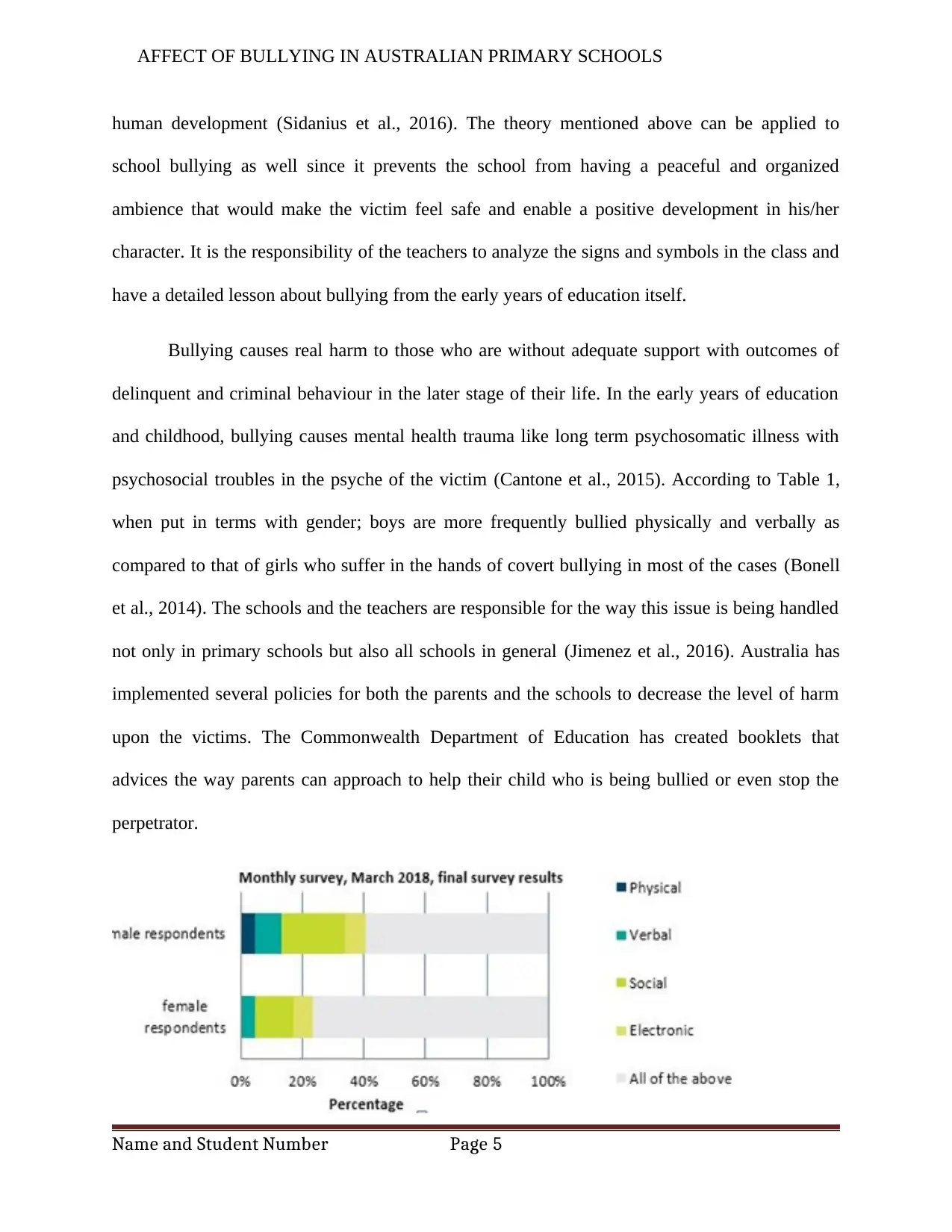
AFFECT OF BULLYING IN AUSTRALIAN PRIMARY SCHOOLS
human development (Sidanius et al., 2016). The theory mentioned above can be applied to
school bullying as well since it prevents the school from having a peaceful and organized
ambience that would make the victim feel safe and enable a positive development in his/her
character. It is the responsibility of the teachers to analyze the signs and symbols in the class and
have a detailed lesson about bullying from the early years of education itself.
Bullying causes real harm to those who are without adequate support with outcomes of
delinquent and criminal behaviour in the later stage of their life. In the early years of education
and childhood, bullying causes mental health trauma like long term psychosomatic illness with
psychosocial troubles in the psyche of the victim (Cantone et al., 2015). According to Table 1,
when put in terms with gender; boys are more frequently bullied physically and verbally as
compared to that of girls who suffer in the hands of covert bullying in most of the cases (Bonell
et al., 2014). The schools and the teachers are responsible for the way this issue is being handled
not only in primary schools but also all schools in general (Jimenez et al., 2016). Australia has
implemented several policies for both the parents and the schools to decrease the level of harm
upon the victims. The Commonwealth Department of Education has created booklets that
advices the way parents can approach to help their child who is being bullied or even stop the
perpetrator.
Name and Student Number Page 5
human development (Sidanius et al., 2016). The theory mentioned above can be applied to
school bullying as well since it prevents the school from having a peaceful and organized
ambience that would make the victim feel safe and enable a positive development in his/her
character. It is the responsibility of the teachers to analyze the signs and symbols in the class and
have a detailed lesson about bullying from the early years of education itself.
Bullying causes real harm to those who are without adequate support with outcomes of
delinquent and criminal behaviour in the later stage of their life. In the early years of education
and childhood, bullying causes mental health trauma like long term psychosomatic illness with
psychosocial troubles in the psyche of the victim (Cantone et al., 2015). According to Table 1,
when put in terms with gender; boys are more frequently bullied physically and verbally as
compared to that of girls who suffer in the hands of covert bullying in most of the cases (Bonell
et al., 2014). The schools and the teachers are responsible for the way this issue is being handled
not only in primary schools but also all schools in general (Jimenez et al., 2016). Australia has
implemented several policies for both the parents and the schools to decrease the level of harm
upon the victims. The Commonwealth Department of Education has created booklets that
advices the way parents can approach to help their child who is being bullied or even stop the
perpetrator.
Name and Student Number Page 5
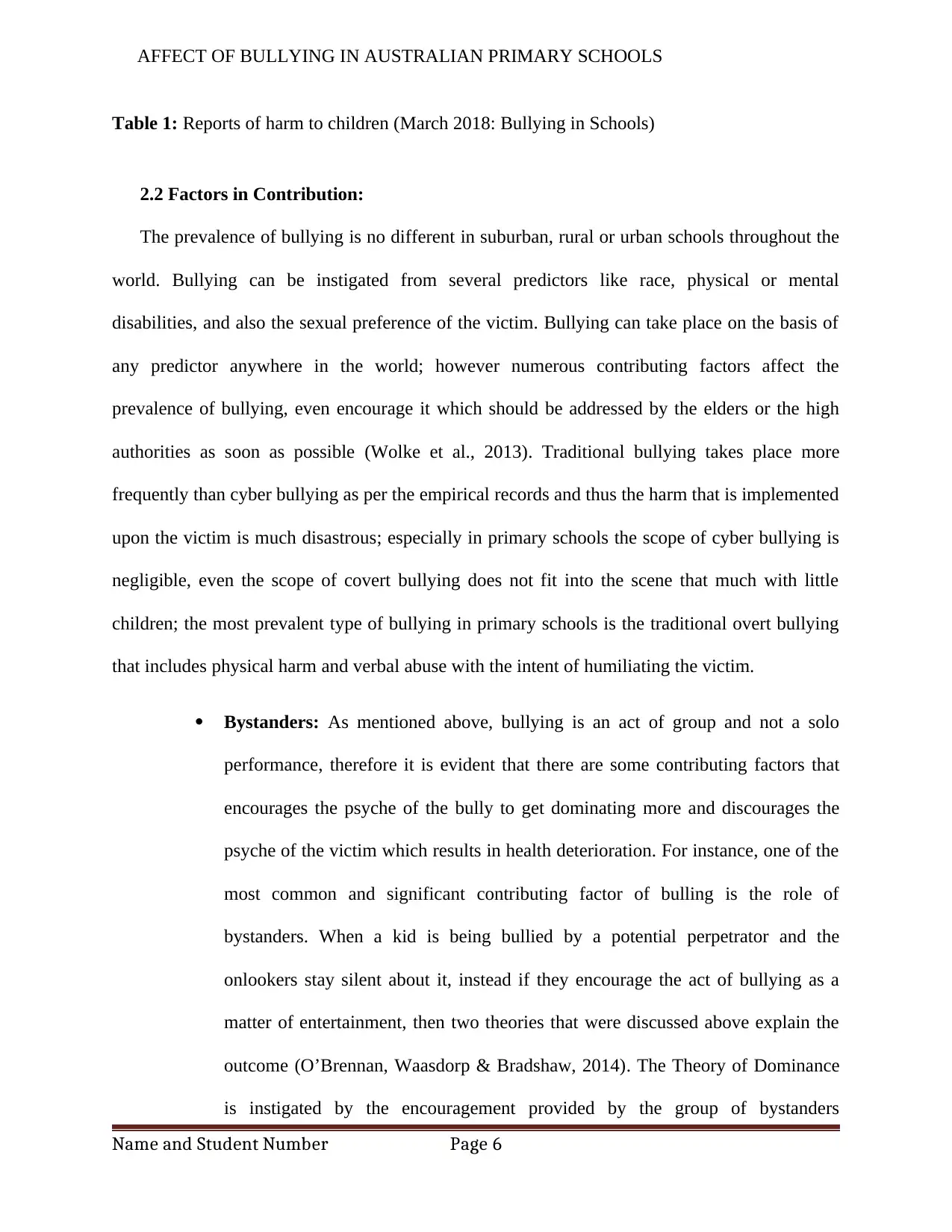
AFFECT OF BULLYING IN AUSTRALIAN PRIMARY SCHOOLS
Table 1: Reports of harm to children (March 2018: Bullying in Schools)
2.2 Factors in Contribution:
The prevalence of bullying is no different in suburban, rural or urban schools throughout the
world. Bullying can be instigated from several predictors like race, physical or mental
disabilities, and also the sexual preference of the victim. Bullying can take place on the basis of
any predictor anywhere in the world; however numerous contributing factors affect the
prevalence of bullying, even encourage it which should be addressed by the elders or the high
authorities as soon as possible (Wolke et al., 2013). Traditional bullying takes place more
frequently than cyber bullying as per the empirical records and thus the harm that is implemented
upon the victim is much disastrous; especially in primary schools the scope of cyber bullying is
negligible, even the scope of covert bullying does not fit into the scene that much with little
children; the most prevalent type of bullying in primary schools is the traditional overt bullying
that includes physical harm and verbal abuse with the intent of humiliating the victim.
Bystanders: As mentioned above, bullying is an act of group and not a solo
performance, therefore it is evident that there are some contributing factors that
encourages the psyche of the bully to get dominating more and discourages the
psyche of the victim which results in health deterioration. For instance, one of the
most common and significant contributing factor of bulling is the role of
bystanders. When a kid is being bullied by a potential perpetrator and the
onlookers stay silent about it, instead if they encourage the act of bullying as a
matter of entertainment, then two theories that were discussed above explain the
outcome (O’Brennan, Waasdorp & Bradshaw, 2014). The Theory of Dominance
is instigated by the encouragement provided by the group of bystanders
Name and Student Number Page 6
Table 1: Reports of harm to children (March 2018: Bullying in Schools)
2.2 Factors in Contribution:
The prevalence of bullying is no different in suburban, rural or urban schools throughout the
world. Bullying can be instigated from several predictors like race, physical or mental
disabilities, and also the sexual preference of the victim. Bullying can take place on the basis of
any predictor anywhere in the world; however numerous contributing factors affect the
prevalence of bullying, even encourage it which should be addressed by the elders or the high
authorities as soon as possible (Wolke et al., 2013). Traditional bullying takes place more
frequently than cyber bullying as per the empirical records and thus the harm that is implemented
upon the victim is much disastrous; especially in primary schools the scope of cyber bullying is
negligible, even the scope of covert bullying does not fit into the scene that much with little
children; the most prevalent type of bullying in primary schools is the traditional overt bullying
that includes physical harm and verbal abuse with the intent of humiliating the victim.
Bystanders: As mentioned above, bullying is an act of group and not a solo
performance, therefore it is evident that there are some contributing factors that
encourages the psyche of the bully to get dominating more and discourages the
psyche of the victim which results in health deterioration. For instance, one of the
most common and significant contributing factor of bulling is the role of
bystanders. When a kid is being bullied by a potential perpetrator and the
onlookers stay silent about it, instead if they encourage the act of bullying as a
matter of entertainment, then two theories that were discussed above explain the
outcome (O’Brennan, Waasdorp & Bradshaw, 2014). The Theory of Dominance
is instigated by the encouragement provided by the group of bystanders
Name and Student Number Page 6
Paraphrase This Document
Need a fresh take? Get an instant paraphrase of this document with our AI Paraphraser
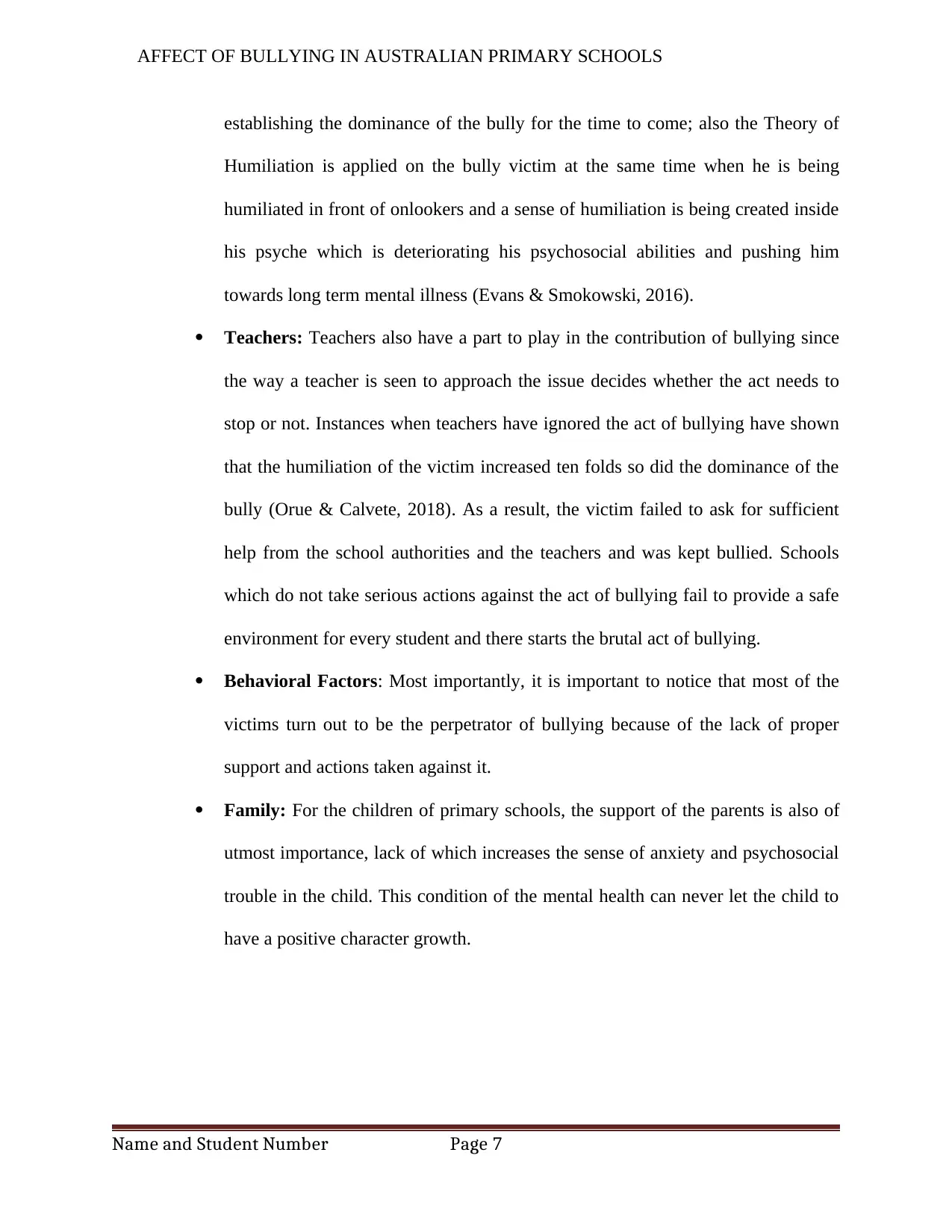
AFFECT OF BULLYING IN AUSTRALIAN PRIMARY SCHOOLS
establishing the dominance of the bully for the time to come; also the Theory of
Humiliation is applied on the bully victim at the same time when he is being
humiliated in front of onlookers and a sense of humiliation is being created inside
his psyche which is deteriorating his psychosocial abilities and pushing him
towards long term mental illness (Evans & Smokowski, 2016).
Teachers: Teachers also have a part to play in the contribution of bullying since
the way a teacher is seen to approach the issue decides whether the act needs to
stop or not. Instances when teachers have ignored the act of bullying have shown
that the humiliation of the victim increased ten folds so did the dominance of the
bully (Orue & Calvete, 2018). As a result, the victim failed to ask for sufficient
help from the school authorities and the teachers and was kept bullied. Schools
which do not take serious actions against the act of bullying fail to provide a safe
environment for every student and there starts the brutal act of bullying.
Behavioral Factors: Most importantly, it is important to notice that most of the
victims turn out to be the perpetrator of bullying because of the lack of proper
support and actions taken against it.
Family: For the children of primary schools, the support of the parents is also of
utmost importance, lack of which increases the sense of anxiety and psychosocial
trouble in the child. This condition of the mental health can never let the child to
have a positive character growth.
Name and Student Number Page 7
establishing the dominance of the bully for the time to come; also the Theory of
Humiliation is applied on the bully victim at the same time when he is being
humiliated in front of onlookers and a sense of humiliation is being created inside
his psyche which is deteriorating his psychosocial abilities and pushing him
towards long term mental illness (Evans & Smokowski, 2016).
Teachers: Teachers also have a part to play in the contribution of bullying since
the way a teacher is seen to approach the issue decides whether the act needs to
stop or not. Instances when teachers have ignored the act of bullying have shown
that the humiliation of the victim increased ten folds so did the dominance of the
bully (Orue & Calvete, 2018). As a result, the victim failed to ask for sufficient
help from the school authorities and the teachers and was kept bullied. Schools
which do not take serious actions against the act of bullying fail to provide a safe
environment for every student and there starts the brutal act of bullying.
Behavioral Factors: Most importantly, it is important to notice that most of the
victims turn out to be the perpetrator of bullying because of the lack of proper
support and actions taken against it.
Family: For the children of primary schools, the support of the parents is also of
utmost importance, lack of which increases the sense of anxiety and psychosocial
trouble in the child. This condition of the mental health can never let the child to
have a positive character growth.
Name and Student Number Page 7
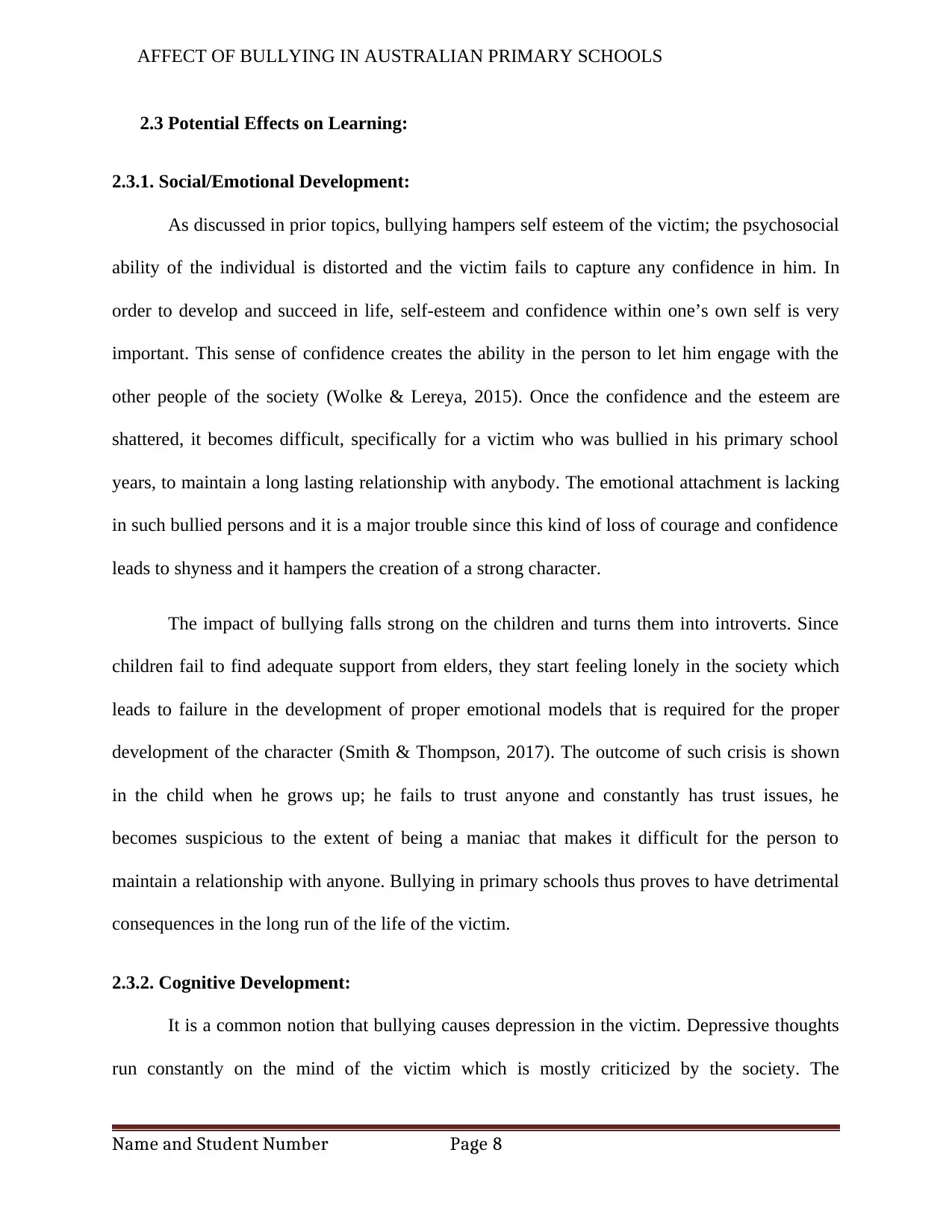
AFFECT OF BULLYING IN AUSTRALIAN PRIMARY SCHOOLS
2.3 Potential Effects on Learning:
2.3.1. Social/Emotional Development:
As discussed in prior topics, bullying hampers self esteem of the victim; the psychosocial
ability of the individual is distorted and the victim fails to capture any confidence in him. In
order to develop and succeed in life, self-esteem and confidence within one’s own self is very
important. This sense of confidence creates the ability in the person to let him engage with the
other people of the society (Wolke & Lereya, 2015). Once the confidence and the esteem are
shattered, it becomes difficult, specifically for a victim who was bullied in his primary school
years, to maintain a long lasting relationship with anybody. The emotional attachment is lacking
in such bullied persons and it is a major trouble since this kind of loss of courage and confidence
leads to shyness and it hampers the creation of a strong character.
The impact of bullying falls strong on the children and turns them into introverts. Since
children fail to find adequate support from elders, they start feeling lonely in the society which
leads to failure in the development of proper emotional models that is required for the proper
development of the character (Smith & Thompson, 2017). The outcome of such crisis is shown
in the child when he grows up; he fails to trust anyone and constantly has trust issues, he
becomes suspicious to the extent of being a maniac that makes it difficult for the person to
maintain a relationship with anyone. Bullying in primary schools thus proves to have detrimental
consequences in the long run of the life of the victim.
2.3.2. Cognitive Development:
It is a common notion that bullying causes depression in the victim. Depressive thoughts
run constantly on the mind of the victim which is mostly criticized by the society. The
Name and Student Number Page 8
2.3 Potential Effects on Learning:
2.3.1. Social/Emotional Development:
As discussed in prior topics, bullying hampers self esteem of the victim; the psychosocial
ability of the individual is distorted and the victim fails to capture any confidence in him. In
order to develop and succeed in life, self-esteem and confidence within one’s own self is very
important. This sense of confidence creates the ability in the person to let him engage with the
other people of the society (Wolke & Lereya, 2015). Once the confidence and the esteem are
shattered, it becomes difficult, specifically for a victim who was bullied in his primary school
years, to maintain a long lasting relationship with anybody. The emotional attachment is lacking
in such bullied persons and it is a major trouble since this kind of loss of courage and confidence
leads to shyness and it hampers the creation of a strong character.
The impact of bullying falls strong on the children and turns them into introverts. Since
children fail to find adequate support from elders, they start feeling lonely in the society which
leads to failure in the development of proper emotional models that is required for the proper
development of the character (Smith & Thompson, 2017). The outcome of such crisis is shown
in the child when he grows up; he fails to trust anyone and constantly has trust issues, he
becomes suspicious to the extent of being a maniac that makes it difficult for the person to
maintain a relationship with anyone. Bullying in primary schools thus proves to have detrimental
consequences in the long run of the life of the victim.
2.3.2. Cognitive Development:
It is a common notion that bullying causes depression in the victim. Depressive thoughts
run constantly on the mind of the victim which is mostly criticized by the society. The
Name and Student Number Page 8

AFFECT OF BULLYING IN AUSTRALIAN PRIMARY SCHOOLS
depression goes to the extent of such a point that children are seen to attempt suicide in schools.
Although the number of suicides in the primary schools is not much alarming, yet being bullied
from an early level of education leads to emotions like depression piled up altogether and it may
lead to a suicidal result later in the life of the victim (Schott & Sondergaard, 2014). Depression is
a negative attribute that is attained from bullying and the impact it has on a child is critical since
children find it hard to handle the issue. Moreover without adequate support from teachers and
family it becomes next to impossible for the child victim to even know the happenings around
him.
The academic performance of the student in the school is heavily affected when he or she
becomes victim in the hands of a bully. All the depression acquired from bullying makes the
student disinterested in his or her studies and if noticed it will be found that the student will fail
to attend the classes and prefer absenteeism rather than trying to in classes and make amends.
Students who are less resilient towards bullying can be seen to try and manage the situation by
making amends with the bully or standing up against him (Tattum & Tattum, 2017). If the
school is providing a porous environment then it is evident that the student will have imbalance
in his emotional and his cognitive abilities due to the bullying faced by him in the school.
2.4 Inclusive Education Policies:
It is important for every school to develop a policy called Bullying Prevention Policy
within the school premises. Australian schools have started to implement anti-bullying
programs in schools and colleges to bind the detrimental consequences of bullying. It was
advised by experts that the programs that are applied in the schools against bullying should
have long-term objectives for better impact (National Academics of Sciences, 2016). Some
of the policies and programs induced in schools all throughout Australia are Mind Matters:
Name and Student Number Page 9
depression goes to the extent of such a point that children are seen to attempt suicide in schools.
Although the number of suicides in the primary schools is not much alarming, yet being bullied
from an early level of education leads to emotions like depression piled up altogether and it may
lead to a suicidal result later in the life of the victim (Schott & Sondergaard, 2014). Depression is
a negative attribute that is attained from bullying and the impact it has on a child is critical since
children find it hard to handle the issue. Moreover without adequate support from teachers and
family it becomes next to impossible for the child victim to even know the happenings around
him.
The academic performance of the student in the school is heavily affected when he or she
becomes victim in the hands of a bully. All the depression acquired from bullying makes the
student disinterested in his or her studies and if noticed it will be found that the student will fail
to attend the classes and prefer absenteeism rather than trying to in classes and make amends.
Students who are less resilient towards bullying can be seen to try and manage the situation by
making amends with the bully or standing up against him (Tattum & Tattum, 2017). If the
school is providing a porous environment then it is evident that the student will have imbalance
in his emotional and his cognitive abilities due to the bullying faced by him in the school.
2.4 Inclusive Education Policies:
It is important for every school to develop a policy called Bullying Prevention Policy
within the school premises. Australian schools have started to implement anti-bullying
programs in schools and colleges to bind the detrimental consequences of bullying. It was
advised by experts that the programs that are applied in the schools against bullying should
have long-term objectives for better impact (National Academics of Sciences, 2016). Some
of the policies and programs induced in schools all throughout Australia are Mind Matters:
Name and Student Number Page 9
Secure Best Marks with AI Grader
Need help grading? Try our AI Grader for instant feedback on your assignments.
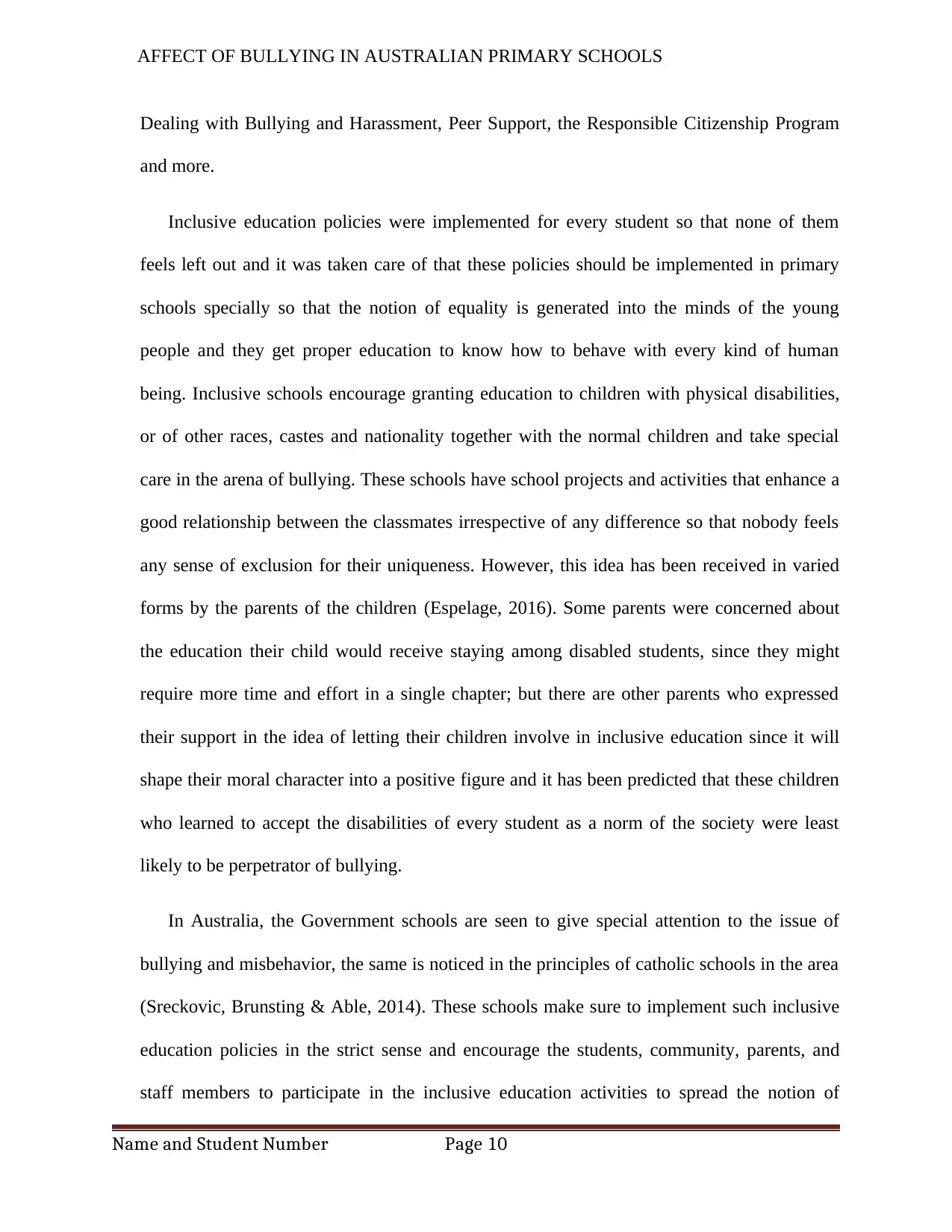
AFFECT OF BULLYING IN AUSTRALIAN PRIMARY SCHOOLS
Dealing with Bullying and Harassment, Peer Support, the Responsible Citizenship Program
and more.
Inclusive education policies were implemented for every student so that none of them
feels left out and it was taken care of that these policies should be implemented in primary
schools specially so that the notion of equality is generated into the minds of the young
people and they get proper education to know how to behave with every kind of human
being. Inclusive schools encourage granting education to children with physical disabilities,
or of other races, castes and nationality together with the normal children and take special
care in the arena of bullying. These schools have school projects and activities that enhance a
good relationship between the classmates irrespective of any difference so that nobody feels
any sense of exclusion for their uniqueness. However, this idea has been received in varied
forms by the parents of the children (Espelage, 2016). Some parents were concerned about
the education their child would receive staying among disabled students, since they might
require more time and effort in a single chapter; but there are other parents who expressed
their support in the idea of letting their children involve in inclusive education since it will
shape their moral character into a positive figure and it has been predicted that these children
who learned to accept the disabilities of every student as a norm of the society were least
likely to be perpetrator of bullying.
In Australia, the Government schools are seen to give special attention to the issue of
bullying and misbehavior, the same is noticed in the principles of catholic schools in the area
(Sreckovic, Brunsting & Able, 2014). These schools make sure to implement such inclusive
education policies in the strict sense and encourage the students, community, parents, and
staff members to participate in the inclusive education activities to spread the notion of
Name and Student Number Page 10
Dealing with Bullying and Harassment, Peer Support, the Responsible Citizenship Program
and more.
Inclusive education policies were implemented for every student so that none of them
feels left out and it was taken care of that these policies should be implemented in primary
schools specially so that the notion of equality is generated into the minds of the young
people and they get proper education to know how to behave with every kind of human
being. Inclusive schools encourage granting education to children with physical disabilities,
or of other races, castes and nationality together with the normal children and take special
care in the arena of bullying. These schools have school projects and activities that enhance a
good relationship between the classmates irrespective of any difference so that nobody feels
any sense of exclusion for their uniqueness. However, this idea has been received in varied
forms by the parents of the children (Espelage, 2016). Some parents were concerned about
the education their child would receive staying among disabled students, since they might
require more time and effort in a single chapter; but there are other parents who expressed
their support in the idea of letting their children involve in inclusive education since it will
shape their moral character into a positive figure and it has been predicted that these children
who learned to accept the disabilities of every student as a norm of the society were least
likely to be perpetrator of bullying.
In Australia, the Government schools are seen to give special attention to the issue of
bullying and misbehavior, the same is noticed in the principles of catholic schools in the area
(Sreckovic, Brunsting & Able, 2014). These schools make sure to implement such inclusive
education policies in the strict sense and encourage the students, community, parents, and
staff members to participate in the inclusive education activities to spread the notion of
Name and Student Number Page 10
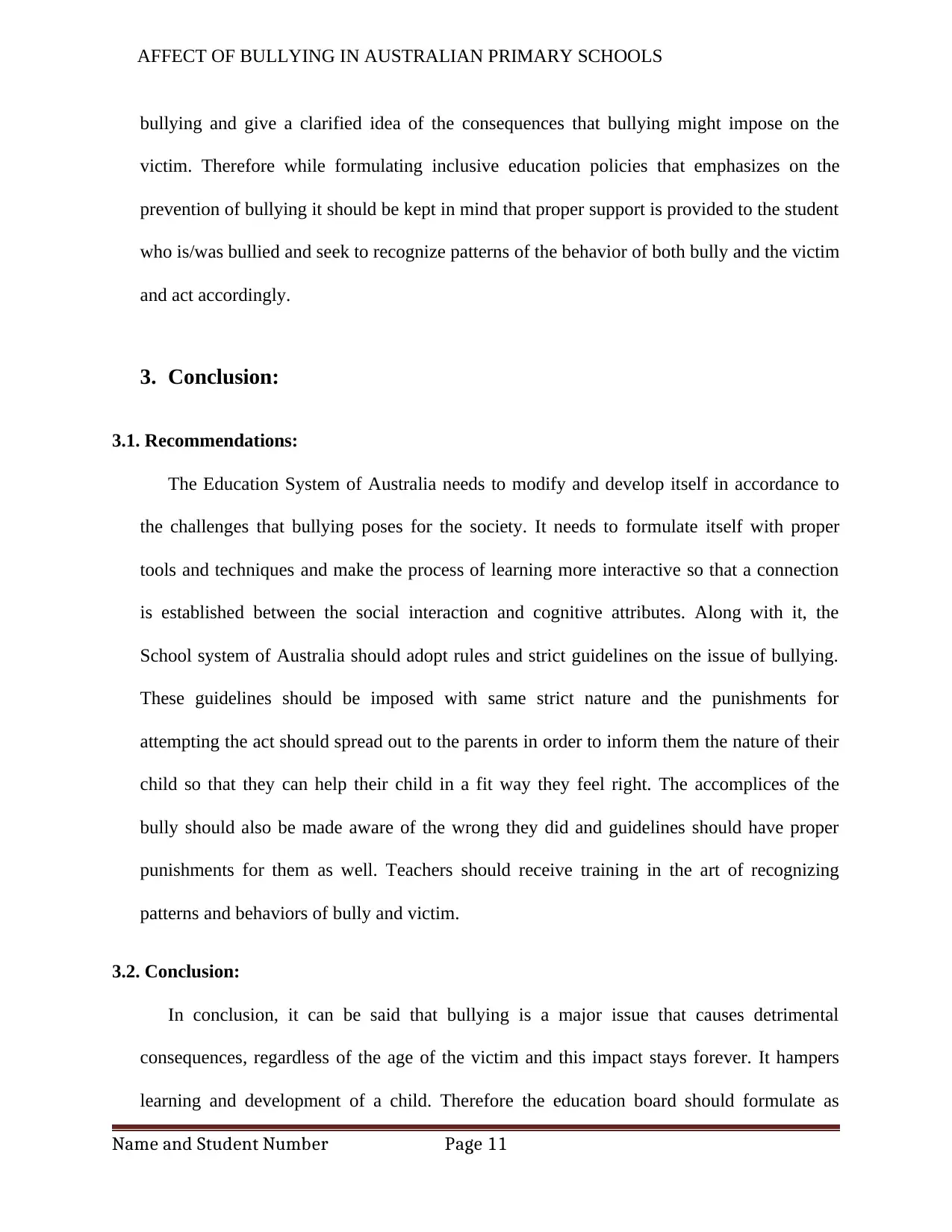
AFFECT OF BULLYING IN AUSTRALIAN PRIMARY SCHOOLS
bullying and give a clarified idea of the consequences that bullying might impose on the
victim. Therefore while formulating inclusive education policies that emphasizes on the
prevention of bullying it should be kept in mind that proper support is provided to the student
who is/was bullied and seek to recognize patterns of the behavior of both bully and the victim
and act accordingly.
3. Conclusion:
3.1. Recommendations:
The Education System of Australia needs to modify and develop itself in accordance to
the challenges that bullying poses for the society. It needs to formulate itself with proper
tools and techniques and make the process of learning more interactive so that a connection
is established between the social interaction and cognitive attributes. Along with it, the
School system of Australia should adopt rules and strict guidelines on the issue of bullying.
These guidelines should be imposed with same strict nature and the punishments for
attempting the act should spread out to the parents in order to inform them the nature of their
child so that they can help their child in a fit way they feel right. The accomplices of the
bully should also be made aware of the wrong they did and guidelines should have proper
punishments for them as well. Teachers should receive training in the art of recognizing
patterns and behaviors of bully and victim.
3.2. Conclusion:
In conclusion, it can be said that bullying is a major issue that causes detrimental
consequences, regardless of the age of the victim and this impact stays forever. It hampers
learning and development of a child. Therefore the education board should formulate as
Name and Student Number Page 11
bullying and give a clarified idea of the consequences that bullying might impose on the
victim. Therefore while formulating inclusive education policies that emphasizes on the
prevention of bullying it should be kept in mind that proper support is provided to the student
who is/was bullied and seek to recognize patterns of the behavior of both bully and the victim
and act accordingly.
3. Conclusion:
3.1. Recommendations:
The Education System of Australia needs to modify and develop itself in accordance to
the challenges that bullying poses for the society. It needs to formulate itself with proper
tools and techniques and make the process of learning more interactive so that a connection
is established between the social interaction and cognitive attributes. Along with it, the
School system of Australia should adopt rules and strict guidelines on the issue of bullying.
These guidelines should be imposed with same strict nature and the punishments for
attempting the act should spread out to the parents in order to inform them the nature of their
child so that they can help their child in a fit way they feel right. The accomplices of the
bully should also be made aware of the wrong they did and guidelines should have proper
punishments for them as well. Teachers should receive training in the art of recognizing
patterns and behaviors of bully and victim.
3.2. Conclusion:
In conclusion, it can be said that bullying is a major issue that causes detrimental
consequences, regardless of the age of the victim and this impact stays forever. It hampers
learning and development of a child. Therefore the education board should formulate as
Name and Student Number Page 11
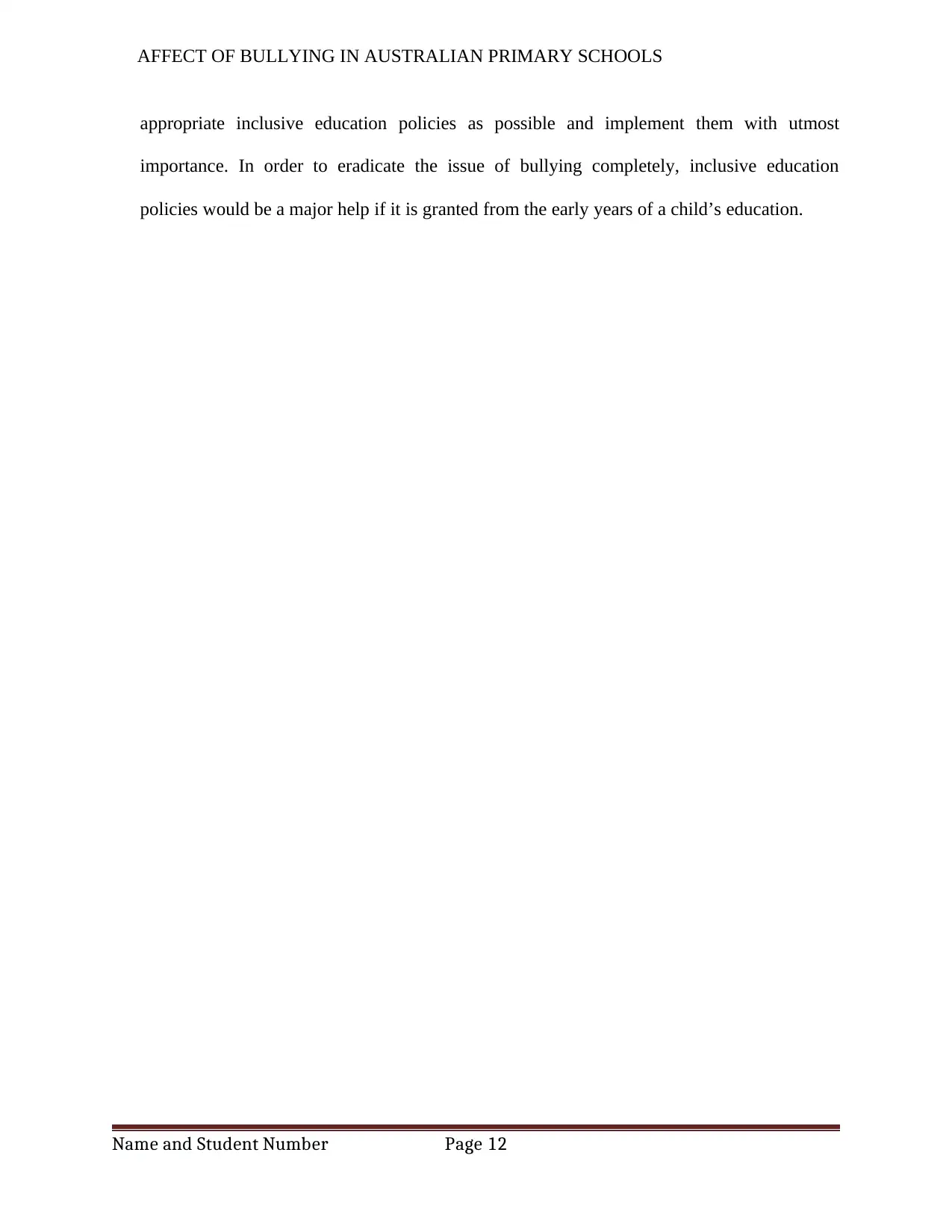
AFFECT OF BULLYING IN AUSTRALIAN PRIMARY SCHOOLS
appropriate inclusive education policies as possible and implement them with utmost
importance. In order to eradicate the issue of bullying completely, inclusive education
policies would be a major help if it is granted from the early years of a child’s education.
Name and Student Number Page 12
appropriate inclusive education policies as possible and implement them with utmost
importance. In order to eradicate the issue of bullying completely, inclusive education
policies would be a major help if it is granted from the early years of a child’s education.
Name and Student Number Page 12
Paraphrase This Document
Need a fresh take? Get an instant paraphrase of this document with our AI Paraphraser

AFFECT OF BULLYING IN AUSTRALIAN PRIMARY SCHOOLS
4. References:
Birchwood, M., Meaden, A., & Trower, P. (2014). Shame, humiliation, and entrapment in
psychosis: a social rank theory approach to cognitive intervention with voices and
delusions. In A casebook of cognitive therapy for psychosis (pp. 124-147). Routledge.
Bonell, C., Allen, E., Christie, D., Elbourne, D., Fletcher, A., Grieve, R., ... & Viner, R. M.
(2014). Initiating change locally in bullying and aggression through the school
environment (INCLUSIVE): study protocol for a cluster randomised controlled
trial. Trials, 15(1), 381.
Cantone, E., Piras, A. P., Vellante, M., Preti, A., Daníelsdóttir, S., D’Aloja, E., ... & Bhugra, D.
(2015). Interventions on bullying and cyberbullying in schools: A systematic
review. Clinical practice and epidemiology in mental health: CP & EMH, 11(Suppl 1
M4), 58.
Espelage, D. L. (2016). Leveraging school-based research to inform bullying prevention and
policy. American Psychologist, 71(8), 768.\ Evans, C. B., Fraser, M. W., & Cotter, K. L.
(2014).
Evans, C. B., & Smokowski, P. R. (2016). Theoretical explanations for bullying in school: How
ecological processes propagate perpetration and victimization. Child and adolescent
social work journal, 33(4), 365-375.
Jansen, P. W., Verlinden, M., Dommisse-van Berkel, A., Mieloo, C. L., Raat, H., Hofman, A., ...
& Tiemeier, H. (2014). Teacher and peer reports of overweight and bullying among
young primary school children. Pediatrics, 134(3), 473-480.
Name and Student Number Page 13
4. References:
Birchwood, M., Meaden, A., & Trower, P. (2014). Shame, humiliation, and entrapment in
psychosis: a social rank theory approach to cognitive intervention with voices and
delusions. In A casebook of cognitive therapy for psychosis (pp. 124-147). Routledge.
Bonell, C., Allen, E., Christie, D., Elbourne, D., Fletcher, A., Grieve, R., ... & Viner, R. M.
(2014). Initiating change locally in bullying and aggression through the school
environment (INCLUSIVE): study protocol for a cluster randomised controlled
trial. Trials, 15(1), 381.
Cantone, E., Piras, A. P., Vellante, M., Preti, A., Daníelsdóttir, S., D’Aloja, E., ... & Bhugra, D.
(2015). Interventions on bullying and cyberbullying in schools: A systematic
review. Clinical practice and epidemiology in mental health: CP & EMH, 11(Suppl 1
M4), 58.
Espelage, D. L. (2016). Leveraging school-based research to inform bullying prevention and
policy. American Psychologist, 71(8), 768.\ Evans, C. B., Fraser, M. W., & Cotter, K. L.
(2014).
Evans, C. B., & Smokowski, P. R. (2016). Theoretical explanations for bullying in school: How
ecological processes propagate perpetration and victimization. Child and adolescent
social work journal, 33(4), 365-375.
Jansen, P. W., Verlinden, M., Dommisse-van Berkel, A., Mieloo, C. L., Raat, H., Hofman, A., ...
& Tiemeier, H. (2014). Teacher and peer reports of overweight and bullying among
young primary school children. Pediatrics, 134(3), 473-480.
Name and Student Number Page 13
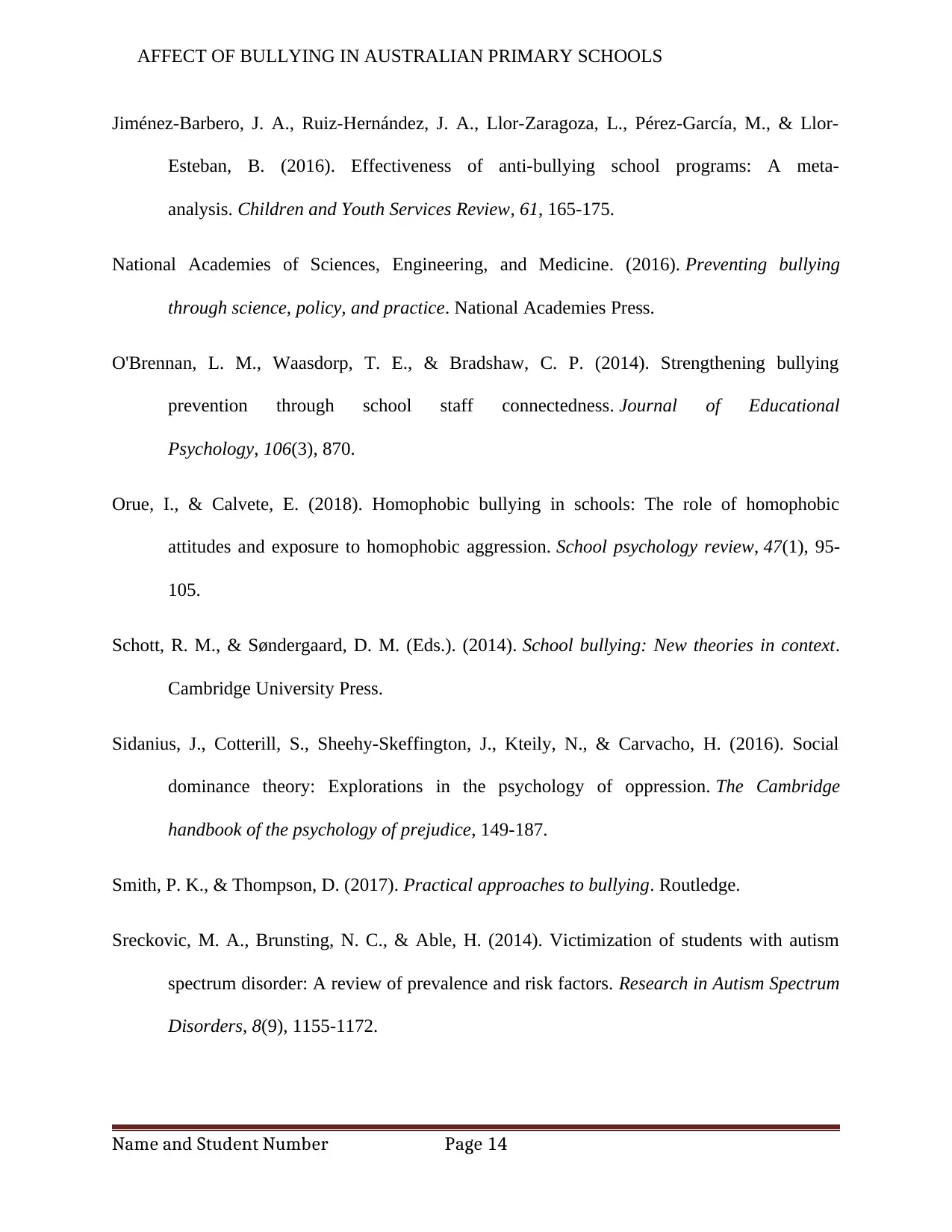
AFFECT OF BULLYING IN AUSTRALIAN PRIMARY SCHOOLS
Jiménez-Barbero, J. A., Ruiz-Hernández, J. A., Llor-Zaragoza, L., Pérez-García, M., & Llor-
Esteban, B. (2016). Effectiveness of anti-bullying school programs: A meta-
analysis. Children and Youth Services Review, 61, 165-175.
National Academies of Sciences, Engineering, and Medicine. (2016). Preventing bullying
through science, policy, and practice. National Academies Press.
O'Brennan, L. M., Waasdorp, T. E., & Bradshaw, C. P. (2014). Strengthening bullying
prevention through school staff connectedness. Journal of Educational
Psychology, 106(3), 870.
Orue, I., & Calvete, E. (2018). Homophobic bullying in schools: The role of homophobic
attitudes and exposure to homophobic aggression. School psychology review, 47(1), 95-
105.
Schott, R. M., & Søndergaard, D. M. (Eds.). (2014). School bullying: New theories in context.
Cambridge University Press.
Sidanius, J., Cotterill, S., Sheehy-Skeffington, J., Kteily, N., & Carvacho, H. (2016). Social
dominance theory: Explorations in the psychology of oppression. The Cambridge
handbook of the psychology of prejudice, 149-187.
Smith, P. K., & Thompson, D. (2017). Practical approaches to bullying. Routledge.
Sreckovic, M. A., Brunsting, N. C., & Able, H. (2014). Victimization of students with autism
spectrum disorder: A review of prevalence and risk factors. Research in Autism Spectrum
Disorders, 8(9), 1155-1172.
Name and Student Number Page 14
Jiménez-Barbero, J. A., Ruiz-Hernández, J. A., Llor-Zaragoza, L., Pérez-García, M., & Llor-
Esteban, B. (2016). Effectiveness of anti-bullying school programs: A meta-
analysis. Children and Youth Services Review, 61, 165-175.
National Academies of Sciences, Engineering, and Medicine. (2016). Preventing bullying
through science, policy, and practice. National Academies Press.
O'Brennan, L. M., Waasdorp, T. E., & Bradshaw, C. P. (2014). Strengthening bullying
prevention through school staff connectedness. Journal of Educational
Psychology, 106(3), 870.
Orue, I., & Calvete, E. (2018). Homophobic bullying in schools: The role of homophobic
attitudes and exposure to homophobic aggression. School psychology review, 47(1), 95-
105.
Schott, R. M., & Søndergaard, D. M. (Eds.). (2014). School bullying: New theories in context.
Cambridge University Press.
Sidanius, J., Cotterill, S., Sheehy-Skeffington, J., Kteily, N., & Carvacho, H. (2016). Social
dominance theory: Explorations in the psychology of oppression. The Cambridge
handbook of the psychology of prejudice, 149-187.
Smith, P. K., & Thompson, D. (2017). Practical approaches to bullying. Routledge.
Sreckovic, M. A., Brunsting, N. C., & Able, H. (2014). Victimization of students with autism
spectrum disorder: A review of prevalence and risk factors. Research in Autism Spectrum
Disorders, 8(9), 1155-1172.
Name and Student Number Page 14

AFFECT OF BULLYING IN AUSTRALIAN PRIMARY SCHOOLS
Tattum, D., & Tattum, E. (2017). Bullying: A whole-school response. In Learning to behave (pp.
67-84). Routledge.
Tolsma, J., van Deurzen, I., Stark, T. H., & Veenstra, R. (2013). Who is bullying whom in
ethnically diverse primary schools? Exploring links between bullying, ethnicity, and
ethnic diversity in Dutch primary schools. Social Networks, 35(1), 51-61.
Tsitsika, A. K., Barlou, E., Andrie, E., Dimitropoulou, C., Tzavela, E. C., Janikian, M., & Tsolia,
M. (2014). Bullying behaviors in children and adolescents:“an ongoing story”. Frontiers
in public health, 2, 7.
Wang, C., Berry, B., & Swearer, S. M. (2013). The critical role of school climate in effective
bullying prevention. Theory Into Practice, 52(4), 296-302.
Wolke, D., & Lereya, S. T. (2015). Long-term effects of bullying. Archives of disease in
childhood, 100(9), 879-885.
Wolke, D., Copeland, W. E., Angold, A., & Costello, E. J. (2013). Impact of bullying in
childhood on adult health, wealth, crime, and social outcomes. Psychological
science, 24(10), 1958-1970.
Name and Student Number Page 15
Tattum, D., & Tattum, E. (2017). Bullying: A whole-school response. In Learning to behave (pp.
67-84). Routledge.
Tolsma, J., van Deurzen, I., Stark, T. H., & Veenstra, R. (2013). Who is bullying whom in
ethnically diverse primary schools? Exploring links between bullying, ethnicity, and
ethnic diversity in Dutch primary schools. Social Networks, 35(1), 51-61.
Tsitsika, A. K., Barlou, E., Andrie, E., Dimitropoulou, C., Tzavela, E. C., Janikian, M., & Tsolia,
M. (2014). Bullying behaviors in children and adolescents:“an ongoing story”. Frontiers
in public health, 2, 7.
Wang, C., Berry, B., & Swearer, S. M. (2013). The critical role of school climate in effective
bullying prevention. Theory Into Practice, 52(4), 296-302.
Wolke, D., & Lereya, S. T. (2015). Long-term effects of bullying. Archives of disease in
childhood, 100(9), 879-885.
Wolke, D., Copeland, W. E., Angold, A., & Costello, E. J. (2013). Impact of bullying in
childhood on adult health, wealth, crime, and social outcomes. Psychological
science, 24(10), 1958-1970.
Name and Student Number Page 15
1 out of 16
Related Documents
Your All-in-One AI-Powered Toolkit for Academic Success.
+13062052269
info@desklib.com
Available 24*7 on WhatsApp / Email
![[object Object]](/_next/static/media/star-bottom.7253800d.svg)
Unlock your academic potential
© 2024 | Zucol Services PVT LTD | All rights reserved.





